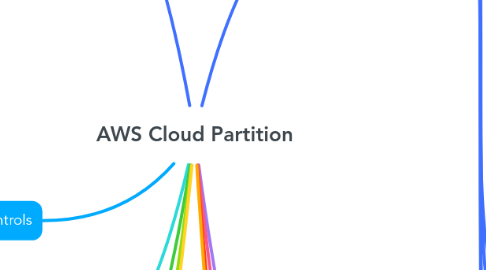
1. Best Practice
1.1. Decoupling
1.1.1. Reduces inter-dependency so that failures do not impact to another component
1.1.2. Smaller
1.2. Designing Solution
1.2.1. Stop guessing your capacity
1.2.2. Test systems at production scale
1.2.3. Automate to make architectural experimentation easier
1.2.4. Allow for evolutionary architectures
1.2.5. Drive architectures using data
1.2.6. Improve through game days
1.3. Single point of failure
1.4. Architecture principle of elasticity
2. AWS Shared Controls
2.1. Patch Management
2.1.1. Patching their guest OS and applications
2.2. Configuration Management
2.2.1. Operating Systems
2.2.2. Database
2.2.3. Application
2.3. Awareness & Training
2.3.1. Train their own employees
3. AWS Share reponsibility
3.1. Protecting the confidentiality of data transit
4. Reliability of AWS
4.1. Recover quickly from failures
4.2. Automatic provisioning new resource to meet demand
5. Legal
5.1. Aws Artifact
5.1.1. Manage their agreements
5.2. Aws Acceptable Use Policy
5.2.1. Without authorization from aws
6. AWS Managed Service
7. AWS Services
7.1. EC2
7.1.1. Purchase option
7.1.1.1. On-deman instance
7.1.1.1.1. Least Commitment
7.1.1.2. Spot instance
7.1.1.2.1. Biggest Savings
7.1.1.3. Reserved Instance
7.1.1.3.1. Best Long-term
7.1.1.4. Dedicated instance
7.1.1.4.1. Most Expensive
7.1.2. Type
7.1.2.1. General Purpose
7.1.2.1.1. Balance between cpu and memory
7.1.2.2. Compute Optimized
7.1.2.2.1. High ratio of compute to memory
7.1.2.2.2. CPU
7.1.2.3. Memory Optiomized
7.1.2.3.1. Good for memory databse
7.1.2.3.2. RAM
7.1.2.4. Accelerated Computing
7.1.2.4.1. Best graphics processing
7.1.2.4.2. GPU
7.1.2.5. Storage Optimized
7.1.2.5.1. SSD & HHD backend
7.2. AWS Database
7.2.1. Relational
7.2.1.1. AWS RDS
7.2.1.1.1. Scale
7.2.1.1.2. Operate
7.2.1.2. AWS Aurora
7.2.1.2.1. PostgreSQL
7.2.1.2.2. MySql
7.2.1.3. AWS Redshift
7.2.1.3.1. Data warehouse
7.2.1.3.2. Analyze all your data
7.2.2. Key-value
7.2.2.1. DynamoDB
7.2.2.1.1. NoSQL
7.2.2.1.2. Fast and Flexible
7.2.3. In memory
7.2.3.1. Elasticache
7.2.3.2. Memory database for Redis
7.2.4. Document
7.2.4.1. Json
7.2.4.2. MongoDB
7.2.5. Graph (graphic, chart)
7.2.5.1. Amazon Neptune
7.2.5.1.1. Social networking
7.2.5.1.2. Fraud detection
7.2.5.1.3. Dataset
7.3. CloudFront
7.3.1. Content delivery network (CND)
7.3.2. Data, video, image, application to customer in global
7.3.3. AWS Edge Locations
7.3.3.1. Distribute content to global
7.4. Storage
7.4.1. Object level
7.4.1.1. AWS S3
7.4.1.1.1. Standard
7.4.1.1.2. Standard IA
7.4.1.1.3. Intelligent
7.4.1.1.4. Glacier
7.4.1.1.5. Glacier deep Archive
7.4.2. Block level
7.4.2.1. EBS
7.4.2.1.1. Attach in EC2
7.4.2.2. Instance Store
7.4.2.2.1. default storage in EC2
7.4.3. File level
7.4.3.1. AWS EFS
7.4.3.1.1. Share access to EC2
7.5. Network
7.5.1. AWS Route53
7.5.1.1. Domain Name System (DNS)
7.5.2. VPC
8. Tools & Sercurity
8.1. Tools
8.1.1. AWS CLI
8.1.1.1. Tool
8.1.1.2. Command line interface
8.1.2. AWS Management Console:
8.1.2.1. Web based user interface
8.2. Sercurity
8.2.1. Aws Inspector
8.2.1.1. Automated security assessment service
8.2.2. AWS Trusted avidsor
8.2.2.1. Offers a rich set of best practice
8.2.2.2. Cost optimization
8.2.2.3. Security
8.2.2.4. Perfomance
8.2.2.5. Service limit
8.2.2.6. Fault tolerance
9. Monioring
9.1. AWS Health Dashboard
9.1.1. Personalized view aws health service
9.1.2. Troubleshooting guidance to aws events impacting to your reseouces
9.2. Cloud Watch
9.2.1. monitor all aws resources
9.2.2. Collect and track metric
9.2.3. Log files
9.2.4. Set alarm & noti
9.3. CloudTrail
9.3.1. Monitor all user actions
10. Cost
10.1. AWS Auto Scaling
10.1.1. automates the process of adding/removing server capacity
10.2. AWS Budgets
10.2.1. Set custom budgets
10.2.2. alert you when your cost or exceed over than budgets amout
10.3. Discount
10.3.1. Consolidated billing for many diffent account
10.4. AWS Cost Explore
10.4.1. Enable you use interface let you visualize, undertand, and manage your cost and usage overtime
11. Support
11.1. Basic Support
11.1.1. Abuse Team
11.2. Security Support
11.2.1. Security team
11.3. Billing Support
11.3.1. Concierge team
11.4. Professinal Service
11.4.1. Help design, architect, build, mirgate
